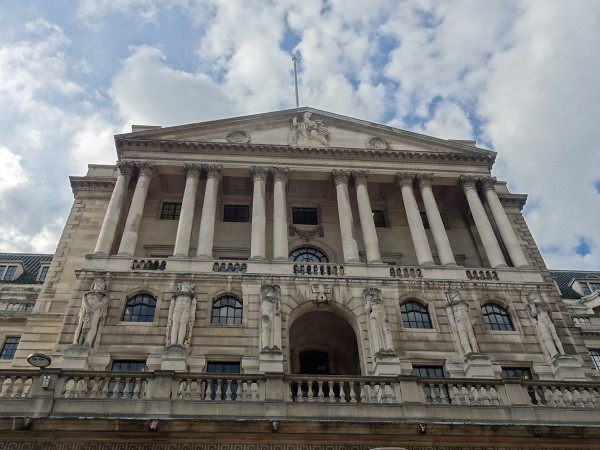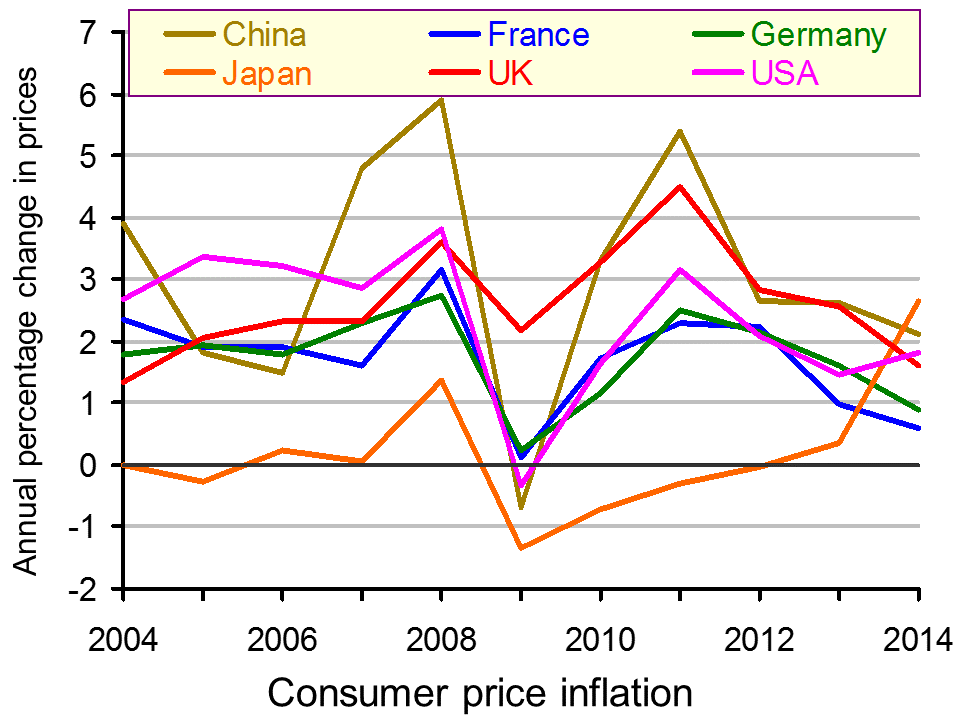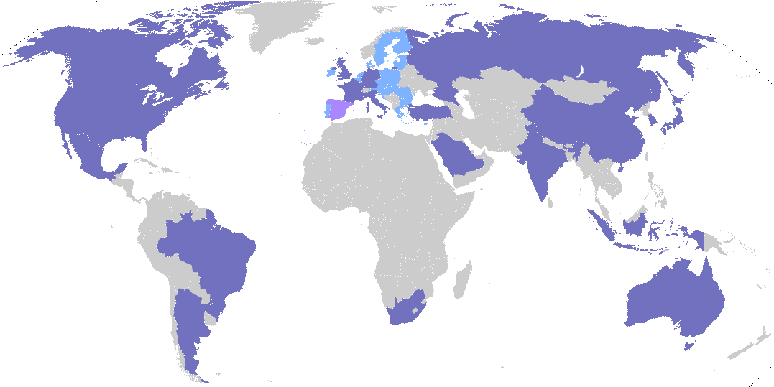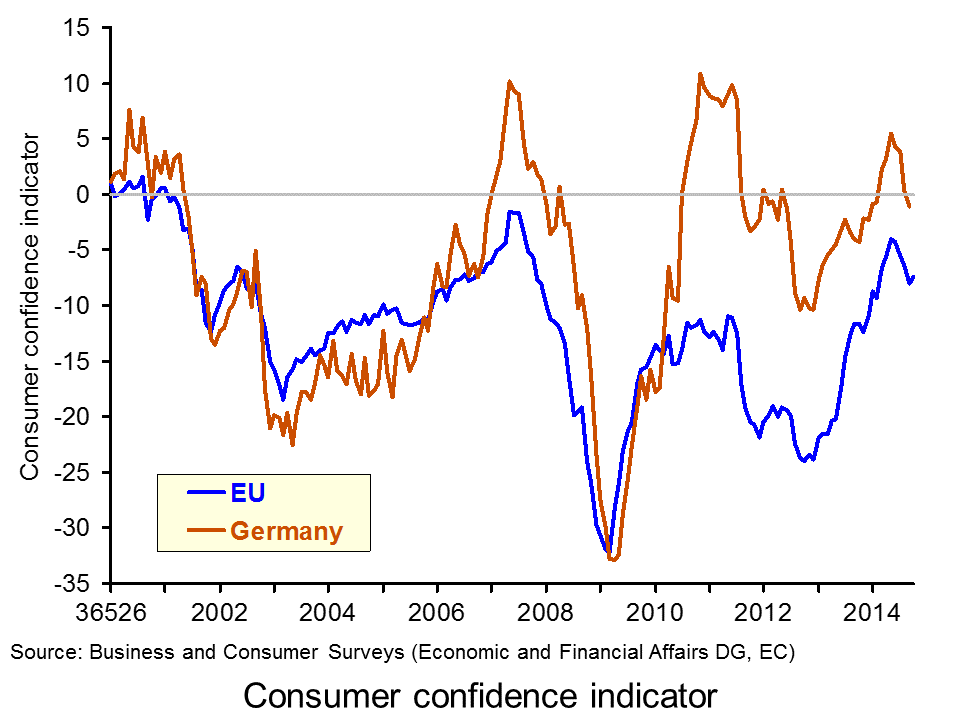 The articles linked below look at the dangers of deflation and policies of central banks to counter it.
The articles linked below look at the dangers of deflation and policies of central banks to counter it.
Deflation in economics has three meanings. The first is falling prices: i.e. negative inflation. The second, more traditional meaning, is a fall in real aggregate demand, resulting in lower output, higher unemployment and lower inflation – and quite possibly an actual fall in the price level. These first two definitions describe what is generally seen as an undesirable situation. The third is a slowing down in the growth of real aggregate demand, perhaps as a result of a deliberate act of fiscal and/or monetary policy. This third meaning could describe a desirable situation, where unsustainable growth is reduced and inflation is reduced from an above-target level.
Here we focus on the first definition. The first two articles look at the dangers of a fall in the price level. The chart below shows falling inflation, although not actually deflation, in China, France, Germany and the UK (click here for a PowerPoint). Several European countries, however, are experiencing actual deflation. These include: Greece, Spain, Hungary, Poland and Sweden. Inflation in the eurozone for 2014 is expected to be a mere 0.5%.
The most obvious danger of deflation (or expected deflation) is that people will delay spending on durable goods, such as cars, furniture and equipment, hoping to buy the items cheaper later.  The result could be a fall in aggregate demand and a fall in output and employment.
The result could be a fall in aggregate demand and a fall in output and employment.
For retailers, this is all spelling Christmas doom. Already the runup to the most crucial time of the year for shops is being characterised by a game of chicken. Shoppers are wondering how long they can leave their festive buying in the hope of late bargains.
Interest rates may be low, but for people with debts, this is being offset by the fact that inflation is no longer reducing the real value of that debt. For people with credit card debt, personal loans and most mortgages, the interest rate they pay is significantly above the rate of inflation. In other words, the real interest rate on their debt is still significantly positive. This may well discourage people from borrowing and spending, further dampening aggregate demand. And, with a Bank Rate of just 0.5%, there is virtually no scope for lowering the official interest rate further.
At least in the UK, economic growth is now positive – for the time being at any rate. The danger is becoming more serious, however, in many eurozone countries, which are already back in recession or close to being so. The ECB, despite its tentative steps to ease credit conditions, it moving closer to the day when it announces full-blown quantitative easing and buys sovereign bonds of eurozone countries. The Bank of Japan has already announced that it is stepping up it QE programme – a vital ingredient in getting Abenomics back on track and pulling Japan out of its latest recession.
In the USA, by contrast, there is little danger of deflation, as the US economy continues to grow strongly. The downside of this, has been a large rise in consumer debt (but not mortgages) – the ingredients of a possible future bubble and even a new financial crisis.
Forget what central bankers say: deflation is the real monster The Observer, Katie Allen (23/11/14)
Why Deflation Is Such A Big Worry For Europe NPR, Jim Zarroli (31/10/14)
Exclusive: China ready to cut rates again on fears of deflation – sources Reuters, Kevin Yao (23/11/14)
Central Banks in New Push to Prime Pump Wall Street Journal Jon Hilsenrath, Brian Blackstone and Lingling Wei (21/11/14)
Are Central Banks Panicking? Seeking Alpha, Leo Kolivakis (21/11/14)
Questions
- What are (a) the desirable and (b) the undesirable consequences of deflation? Does the answer depend on how deflation is defined?
- What is meant by a ‘deflationary gap’? In what sense is ‘deflationary’ being used in this term?
- Why have oil prices been falling? How desirable are these falls for the global economy?
- Is there an optimal rate of inflation? If so, how would this rate be determined?
- The chart shows that inflation in Japan is likely to have risen in 2014. This in large part is the result to a rise in the sales tax earlier this year. If there is no further rise in the sales tax, which there will probably not be if Mr Abe’s party wins the recently called election, what is likely to be the effect of the 2014 tax rise on inflation in 2015?
- If the Bank Rate is below the rate of inflation, why are people facing a positive real rate of interest? Does this apply equally to borrowers and savers?
- In what sense is there a cultural revolution at the Bank of England?
 Since coming to office two years ago, Shinzo Abe’s government has been determined to revive the Japanese economy. The policy has involved ‘three arrows‘: expansionary fiscal policy, expansionary monetary policy and supply-side reforms. But figures just out show that the Japanese economy is back in recession. The economy shrank by 0.4% in quarter 3, having shrunk by 1.9% in quarter 2.
Since coming to office two years ago, Shinzo Abe’s government has been determined to revive the Japanese economy. The policy has involved ‘three arrows‘: expansionary fiscal policy, expansionary monetary policy and supply-side reforms. But figures just out show that the Japanese economy is back in recession. The economy shrank by 0.4% in quarter 3, having shrunk by 1.9% in quarter 2.
This has come as a huge disappointment for Mr Abe, who has staked his political reputation on escaping from deflation and achieving sustained economic growth. In response, he has called a general election to put a revised economic plan to the electorate.

The main cause of the reversal into recession has been an increase in the sales tax on all goods, which has dampened spending. The tax rise, planned by the previous government, was to help reduce the deficit and start tackling the huge public-sector debt, which, at over 230% of GDP, is by far the highest in the developed world. Another rise in sales tax is due in October 2015 – from 8% to 10%. Mr Abe hopes to cancel the rise and it is this that he may put to the electorate.
So what is the outlook for Japan? Will quarter 4 show economic growth, or will pessimism have set in? Will the Bank of Japan introduce even more quantitative easing, or will it wait for the latest increase in QE to take effect (see the blog post, All eased out: at least for the USA and UK)?
The following articles look at the implications of the latest news, both for Japan and globally, and at the options for the government and central bank.
Articles
Japanese economy falls into surprise recession Independent, Maria Tadeo (17/11/14)
Japan’s economy makes surprise fall into recession BBC News (17/11/14)
Coming to a crunch: Time is running out for Abenomics The Economist (20/11/14)
Japan’s economy: Delay the second consumption tax hike The Economist (17/11/14)
Defying Expectations, Japan’s Economy Falls Into Recession New York Times, Jonathan Soble (16/11/14)
Japan shocks as economy slips into recession CNBC, Li Anne Wong (17/11/14)
Japan Unexpectedly Enters Recession as Abe Weighs Tax: Economy Bloomberg, Keiko Ujikane and Toru Fujioka (17/11/14)
The world should be wary: Japan’s economic woes are contagious The Guardian, Larry Elliott (17/11/14)
Why is Japan heading to the polls? BBC News (18/11/14)
Previous news items on this site
A new economic road for Japan? (January 2013)
A J-curve for Japan? (May 2013)
Japan’s three arrows (June 2013)
Abenomics – one year on (December 2013)
Japan’s recovery (January 2014)
Japan’s CPI: An Update (May 2014)
All eased out: at least for the USA and UK (November 2014)
Data
Quarterly Estimates of GDP Japanese Cabinet Office
Japan and the IMF IMF Country Reports
Economic Outlook Annex Tables OECD
Questions
- Give details of the Japanese government’s three arrows.
- Discuss the pros and cons of the rise in the sales tax. Is it possible for the rise in the sales tax to increase the size of the public-sector deficit?
- What have been the effects of Japanese government policies on (a) prices of goods and services; (b) living standards; (c) asset prices?
- Who have been the gainers and losers of the policies?
- How is the Japanese situation likely to effect the value of the yen? How is this, in turn, likely to affect its trading partners? Could this set off a chain reaction?
 This weekend, Australia will play host to the world’s leaders, as the G20 Summit takes place. The focus of the G20 Summit will be on global growth and how it can be promoted. The Eurozone remains on the brink, but Germany did avoid for recession with positive (just) growth in the third quarter of this year. However, despite Australia’s insistence on returning the remit of the G20 to its original aims, in particular promoting growth, it is expected that many other items will also take up the G20’s agenda.
This weekend, Australia will play host to the world’s leaders, as the G20 Summit takes place. The focus of the G20 Summit will be on global growth and how it can be promoted. The Eurozone remains on the brink, but Germany did avoid for recession with positive (just) growth in the third quarter of this year. However, despite Australia’s insistence on returning the remit of the G20 to its original aims, in particular promoting growth, it is expected that many other items will also take up the G20’s agenda.
In February, the G20 Finance Ministers agreed various measures to boost global growth and it is expected that many of the policies discussed this weekend will build on these proposals. The agreement contained a list of new policies that had the aim of boosting economy growth of the economies by an extra 2% over a five year period. If this were to happen, the impact would be around £1.27 trillion. The agreed policies will be set out in more detail as part of the Brisbane Action Plan.
 As well as a discussion of measures to promote global growth as a means of boosting jobs across the world, there will also be a focus on using these measures to prevent deflation from becoming a problem across Europe. Global tax avoidance by some of the major multinationals will also be discussed and leaders will be asked to agree on various measures. These include a common reporting standard; forcing multinationals to report their accounts country by country and principles about disclosing the beneficial ownership of companies. It it also expected that the tensions between Russia and Ukraine will draw attention from the world leaders. But, the main focus will be the economy. Australia’s Prime Minister, Tony Abbott said:
As well as a discussion of measures to promote global growth as a means of boosting jobs across the world, there will also be a focus on using these measures to prevent deflation from becoming a problem across Europe. Global tax avoidance by some of the major multinationals will also be discussed and leaders will be asked to agree on various measures. These include a common reporting standard; forcing multinationals to report their accounts country by country and principles about disclosing the beneficial ownership of companies. It it also expected that the tensions between Russia and Ukraine will draw attention from the world leaders. But, the main focus will be the economy. Australia’s Prime Minister, Tony Abbott said:
“Six years ago, the impacts of the global financial crisis reverberated throughout the world. While those crisis years are behind us, we still struggle with its legacy of debt and joblessness…The challenge for G20 leaders is clear – to lift growth, boost jobs and strengthen financial resilience. We need to encourage demand to ward off the deflation that threatens the major economies of Europe.”
 Many people have protested about the lack of action on climate change, but perhaps this has been addressed to some extent by the deal between China and the USA on climate change and Barak Obama’s pledge to make a substantial contribution to the Green Climate Fund. This has caused some problems and perhaps embarrassment for the host nation, as Australia has remained adamant that despite the importance of climate change, this will not be on the agenda of the G20 Summit. Suggestions now, however, put climate change as the final communique.
Many people have protested about the lack of action on climate change, but perhaps this has been addressed to some extent by the deal between China and the USA on climate change and Barak Obama’s pledge to make a substantial contribution to the Green Climate Fund. This has caused some problems and perhaps embarrassment for the host nation, as Australia has remained adamant that despite the importance of climate change, this will not be on the agenda of the G20 Summit. Suggestions now, however, put climate change as the final communique.
Some people and organisations have criticised the G20 and questioned its relevance, so as well as discussing a variety of key issues, the agenda will more broadly be aiming to address this criticism. And of course, focus will also be on tensions between some of the key G20 leaders. The following articles consider the G20 Summit.
Articles
Ukraine and Russia take center stage as leaders gather for G20 Reuters, Matt Siegel (14/11/14)
The G20 Summit: World leaders gather in Brisbane BBC News (14/11/11)
G20: Obama to pledge $2.5bn to help poor countries on climate change The Guardian, Suzanne Goldenberg (14/11/14)
G20 in 20: All you need to know about Brisbane Leaders summit in 20 facts Independent, Mark Leftly (13/11/14)
G20 leaders to meet in Australia under pressure to prove group’s relevance The Guardian, Lenore Taylor (13/11/14)
Australia PM Abbott accuses Putin of bullying on eve of G20 Financial Times, George Parker and Jamie Smyth (14/11/14)
G20: David Cameron in Australia for world leaders’ summit BBC News (13/11/14)
G20 summit: Australian PM Tony Abbott tries to block climate talks – and risks his country becoming an international laughing stock Independent, Kathy Marks (13/11/14)
Incoming G20 leader Turkey says groups must be more inclusive Reuters, Jane Wardell (14/11/14)
Behind the motorcades and handshakes, what exactly is the G20 all about – and will it achieve ANYTHING? Mail Online, Sarah Michael (14/11/14)
Is the global economy headed for the rocks? BBC News, Robert Peston (17/11/14)
Official G20 site
G20 Priorities G20
Australia 2014 G20
News G20
Questions
- What is the purpose of the G20 and which countries are members of it? Should any others be included in this type of organisation?
- What are the key items on the agenda for the G20 Summit in Brisbane?
- One of the main objectives of this Summit is to discuss the policies that will be implemented to promote growth. What types of policies are likely to be important in promoting global economic growth?
- What types of policies are effective at addressing the problem of deflation?
- What impact will the tensions between Russia and Ukraine have on the progress of the G20?
- Why are multinationals able to engage in tax evasion? What policies could be implemented to prevent this and to what extent is global co-operation needed?
- Discuss possible reforms to the IMF and the G20’s role in promoting such reforms.
- Should the G20 be scrapped?
 The spectre of debt has awoken many of us in the night. Indebtedness is a key economic issue in the 2010s. Economists are devoting ever increasing amounts of research time trying to understand its impact on economic behaviour. This will not surprise you when you learn that the debt owed by the UK non-bank private sector to banks stood at £2.17 trillion at the end of September. This is the equivalent to 150% of annual GDP.
The spectre of debt has awoken many of us in the night. Indebtedness is a key economic issue in the 2010s. Economists are devoting ever increasing amounts of research time trying to understand its impact on economic behaviour. This will not surprise you when you learn that the debt owed by the UK non-bank private sector to banks stood at £2.17 trillion at the end of September. This is the equivalent to 150% of annual GDP.
 Chart 1 shows the stock of outstanding lending by Monetary Financial Institutions (banks and building societies) to the non-bank private sector bank since 1979. Back then the non-bank private sector had bank debt to the tune of around £70 billion or 10 per cent of GDP. Today’s figure is nearly 3000 per cent higher! Of this debt, around about 55 per cent is currently held by the household sector, 27 per cent by Other Financial Corporations (such as insurance companies and pension funds) and 18 per cent by private non-financial corporations. (Click here for a PowerPoint of the chart.)
Chart 1 shows the stock of outstanding lending by Monetary Financial Institutions (banks and building societies) to the non-bank private sector bank since 1979. Back then the non-bank private sector had bank debt to the tune of around £70 billion or 10 per cent of GDP. Today’s figure is nearly 3000 per cent higher! Of this debt, around about 55 per cent is currently held by the household sector, 27 per cent by Other Financial Corporations (such as insurance companies and pension funds) and 18 per cent by private non-financial corporations. (Click here for a PowerPoint of the chart.)
 Chart 2 shows the stocks of debt as percentages of annual GDP. We can infer from it that there are waves of growth in bank debt. Two notable periods are during the 1980s and again from the late 1990s up to the financial crisis of the late 2000s. During the early and mid 1990s the relative size of debt stocks tended to stabilise while in the early 2010s the actual stocks of debt, as well as relative to GDP, declined. A credit binge seems to be followed by a period of consolidation. (Click here for a PowerPoint of the chart.)
Chart 2 shows the stocks of debt as percentages of annual GDP. We can infer from it that there are waves of growth in bank debt. Two notable periods are during the 1980s and again from the late 1990s up to the financial crisis of the late 2000s. During the early and mid 1990s the relative size of debt stocks tended to stabilise while in the early 2010s the actual stocks of debt, as well as relative to GDP, declined. A credit binge seems to be followed by a period of consolidation. (Click here for a PowerPoint of the chart.)
It is important that we understand the drivers of the growth of debt. The impact of debt on the balance sheets of the non-bank private sector and on banks themselves has implications for economic behaviour. In the early 2010s this has been to markedly slow the pace of growth through its impact on aggregate demand. Economic agents have, in general, looked to consolidate. There is no doubt that this partly reflects a precautionary motive. An important means by which debt and the balance sheets on which it is recorded affect behaviour is through a precautionary mechanism. This is difficult to accurately quantify because it represents a psychological influence on spending. Furthermore, it is affected by the prevailing circumstances of the time.
In looking to understand the factors that affect the growth of debt we may, as a result, learn more about the framework within which we may want banks and their customers to operate. Consequently, we may be in a better position to ensure sustainable longer-term growth and development. If there are cycles in credit it is important that we understand why they arise and whether, as some have suggested, they are an inherent part of the financialised economy in which we live. If they are, can we mitigate their potentially destabilising effects?
Articles
Retail shares facing nightmare before Christmas The Telegraph, John Ficenec (9/11/14)
Growing wealth inequality in the UK is a ticking timebomb The Guardian, Danny Dorling (15/10/14)
Richest 10% of Britons now control more than half the country’s wealth: Nation is only member of G7 where inequality between rich and poor has increased this century Mail Online, Mark Duell and Corey Charlton, (15/11/14)
Household debt is growing as families struggle Yorkshire Evening Post (31/10/14)
Consumer spending forecast to be the highest for four years The Telegraph, Ashley Armstrong (10/11/14)
Data
Statistical Interactive Database Bank of England
Quarterly National Accounts, Q2 2014 Dataset Office for National Statistics
Questions
- What is the non-bank private sector?
- What factors might affect the rate at which non-bank private sector debt stocks grow?
- How might we go about assessing whether the aggregate level of lending by financial institutions to the non-bank private sector is sustainable?
- How might we go about assessing whether the level of lending by individual financial institutions to the non-bank private sector is sustainable?
- What information is conveyed in the balance sheets of economic agents, such as households and private non-financial corporations
- What is meant by precautionary saving?
- Can precautionary saving occur when the economy is growing strongly?
- What are the mechanisms by which non-bank private sector debt could impact on economic behaviour?
 In the Blog, A VW recession for the eurozone, as German growth revised down?, we discussed the pessimistic outlook for the eurozone, in part driven by the problems facing the engine of Europe: Germany. While the German government noted that the weak growth figures are due to external factors, it appears as though these external factors are now sending waves through the domestic economy.
In the Blog, A VW recession for the eurozone, as German growth revised down?, we discussed the pessimistic outlook for the eurozone, in part driven by the problems facing the engine of Europe: Germany. While the German government noted that the weak growth figures are due to external factors, it appears as though these external factors are now sending waves through the domestic economy.
Over the past 6 months, German confidence has fallen continuously and now stands at almost its lowest level in 2 years. Think tank data from a survey of 7000 firms in Germany fell from 104.7 to 103.2 for October – the weakest reading since December 2012. Confidence is always a key factor in the strength of an economy, as it affects consumers and businesses.  Without consumer and business confidence, two key components of aggregate demand are weak and this downward pressure on total spending in the economy depresses economic growth. An economist from Ifo, the think-tank that produced this business climate index, said that firms felt ‘downbeat about both their current situation and the future.’
Without consumer and business confidence, two key components of aggregate demand are weak and this downward pressure on total spending in the economy depresses economic growth. An economist from Ifo, the think-tank that produced this business climate index, said that firms felt ‘downbeat about both their current situation and the future.’
As confidence continues to decline in Germany, the economic situation is unlikely to improve. Unfortunately, it is something of a vicious circle in that without economic growth confidence won’t return and without confidence, economic growth won’t improve. The industrial sector is crucial to Germany and the data is concerning, according to Chief economist at Commerzbank, Joerg Kraemer:
The latest numbers from the industrial sector are very worrisome…The third quarter was probably worse than expected, the economy may have stagnated at best.
Numerous factors continue to depress the German economy and while negative growth is not expected, estimates for quarterly growth from July to September remain at around 0.3%. As Europe’s largest economy, such low growth rates will be of concern to the rest of the Eurozone and may also bring worry to other countries, such as the US and UK. With growing interdependence between nations, the success of countries such as Germany and Europe as a whole influences the economic situation abroad. Commentators will be looking for any signal that Germany is strengthening in the coming months and an improvement in business confidence will be essential for any prolonged recovery.
German business confidence falters again in October Wall Street Journal, Todd Buell (27/10/14)
German business morale weakens to lowest level in almost two years Reuters, Michelle Martin (27/10/14)
Zero growth best hope for Germany as confidence disappears The Telegraph, Szu Ping Chan (27/10/14)
German Ifo business confidence drops for sixth month Bloomberg, Stefan Riecher (27/10/14)
German business confidence plunges again as analysts urge fiscal stimulus International Business Times, Finnbarr Bermingham (27/10/14)
German business confidence falls again, Ifo says BBC News (27/10/14)
German business confidence tumbles The Guardian, Philip Inman (24/9/14)
The German way of stagnating BBC News, Robert Peston (11/11/14)
Questions
- Why is consumer and business confidence such an important element in explaining the state of an economy?
- Use an AD/AS diagram to illustrate the impact on national output of a decline business confidence. What are the other consequences for the macroeconomic objectives?
- What actions can a government take to boost confidence in an economy?
- If economic growth is weak and confidence is low, is there any point in cutting interest rates as a means of stimulating investment?
- If the eurozone did move back into recession, what could be the possible consequences for countries such as the UK and US?
- How useful are indices that measure business confidence?
 The articles linked below look at the dangers of deflation and policies of central banks to counter it.
The articles linked below look at the dangers of deflation and policies of central banks to counter it. The result could be a fall in aggregate demand and a fall in output and employment.
The result could be a fall in aggregate demand and a fall in output and employment.








